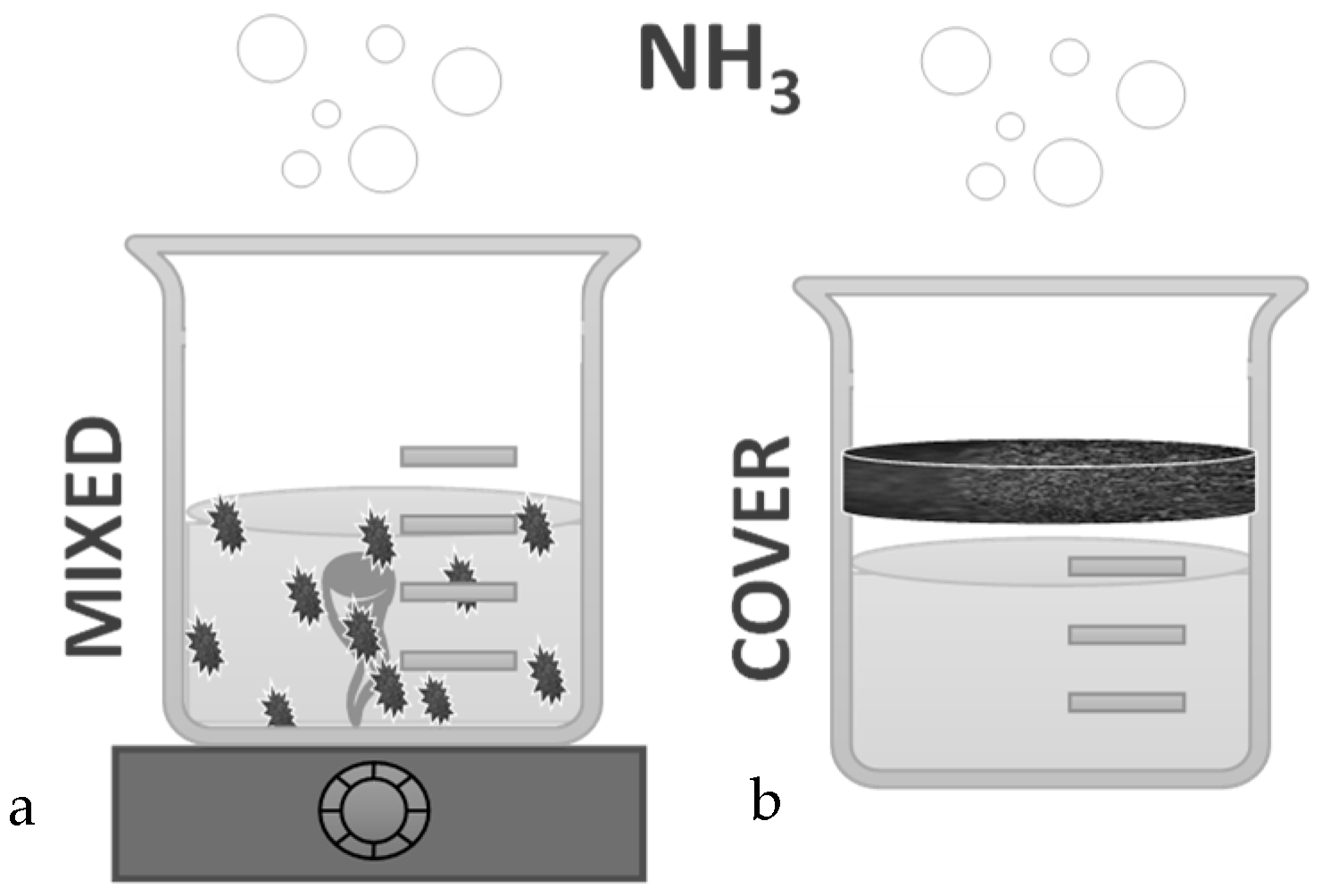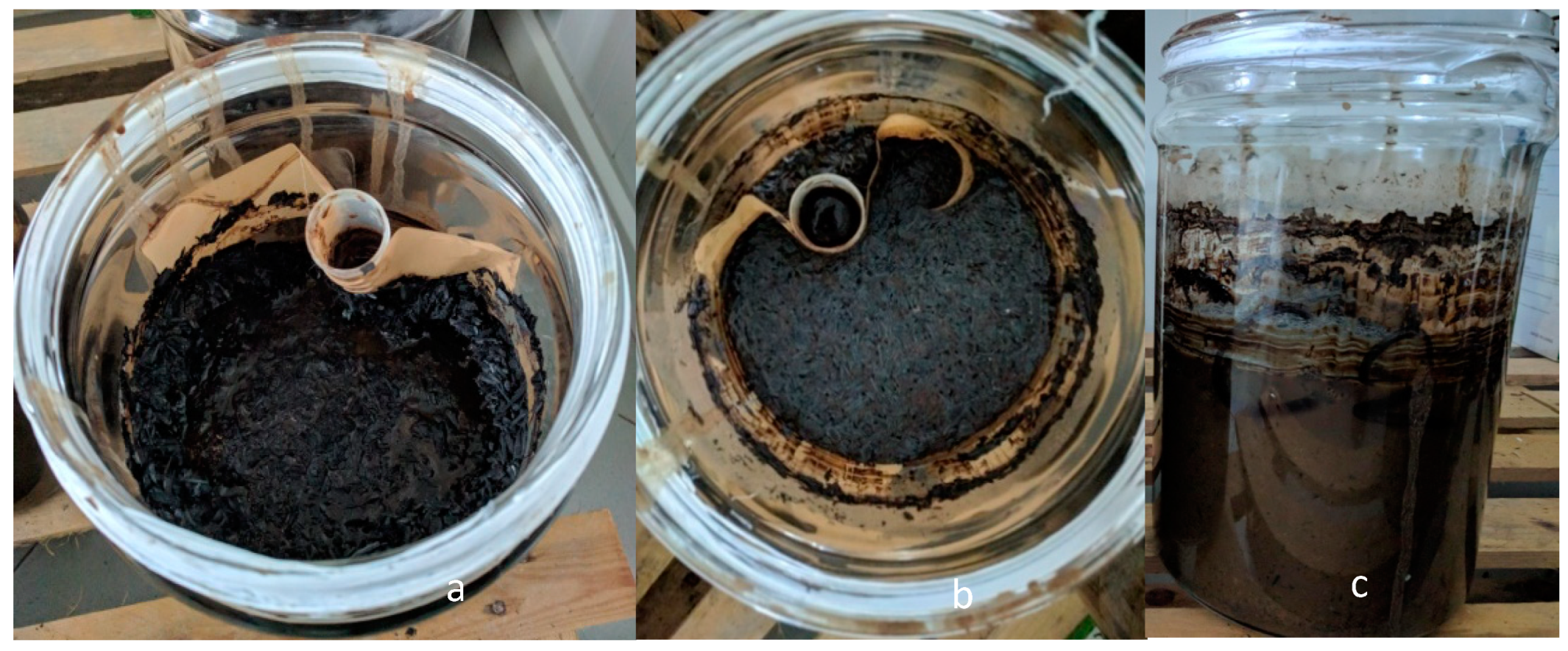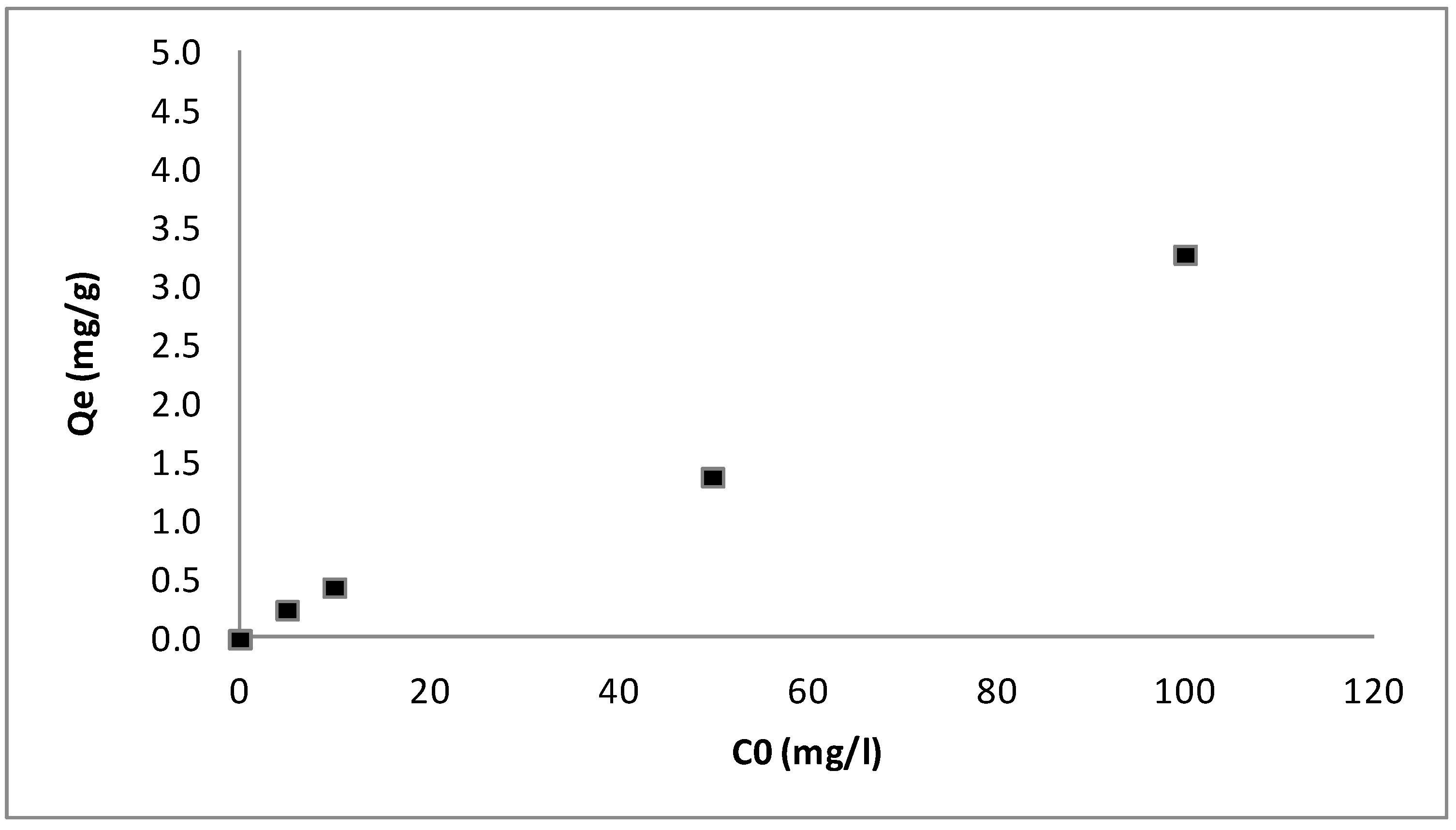An Effective Biochar Application for Reducing Nitrogen Emissions from Buffalo Digestate Storage Tank
Abstract
1. Introduction
2. Materials and Methods
2.1. Characteristics of Materials
2.1.1. Livestock Digestate Characterization
2.1.2. Biochar Characterization
2.2. Ammonia Emissions Assessment from Digestate Storage
2.3. Biochar Adsorption Mechanisms Study
2.3.1. NH4+ Maximum Adsorption Capacity
2.3.2. Adsorption Tests Using Different Biochar Application Methods
3. Results
3.1. Storage Tests: Digestate Characteristics, NH3 Emissions, Surface Monitoring and Biochar Adsorption
3.2. Biochar Adsorption Mechanisms Study
3.2.1. NH4+ Biochar Adsorption Capacity
3.2.2. Assessment of Biochar Ammoniacal N Adsorption Mechanisms
4. Discussion
4.1. Ammonia Emissions
4.2. Biochar Adsorption Mechanisms
| Biochar Characteristics | Liquid Stored Characteristics | NH3 Emissions Reduction (%) | Storage Duration | Ref. | |||||||||
|---|---|---|---|---|---|---|---|---|---|---|---|---|---|
| Feedstock Origin | Pyrolisys Temperature (°C) | pH | pHPZC | Application | Dose | Type | T (°C) | pH | DM | TKN | |||
| corn stover | 500 | 9.2 | 8.42 | One-Time surface Application | 2 kg/m2 | deep pit swine manure | - | - | 4.6–8.2% | 4340–7350 mg/L | 33 | 8 weeks | [39] |
| One-Time surface Application | 4 kg/m2 | 25 | |||||||||||
| Bi-Weekly surface Reapplication | 2 kg/m2 | 53 | |||||||||||
| red oak | 500 | 7.5 | 6.75 | One-Time surface Application | 1.65 kg/m2 | swine manure | - | 7.47 | 2.64% | 16.10% | 19 | 4 weeks | [24] |
| 8 | 4.07% | 13.37% | 21 | ||||||||||
| 7.55 | 2.6% | 11.88% | 39 | ||||||||||
| corn stover | 500 | 9.2 | 8.42 | One-Time surface Application | 2 kg/m2 | 7.47 | 2.64% | 16.10% | 18 | ||||
| 8 | 4.07% | 13.37% | 21 | ||||||||||
| 7.55 | 2.6% | 11.88% | 4 | ||||||||||
| blueleaf (softwood) | 450 | 8.6 | _ | mixing with manure | 0, 2.5, 5, 10, and 25% biochar by volume | liquid swine | 21 | 7.4 | 49 g/kg | 11.1 mgN/L | no reduction | 21 days | [28] |
| dairy slurry | 7.5 | 38 g/kg | 20.4 mgN/L | ||||||||||
| solid poultry manure | 9.4 | 591 g/kg | 44.5 mgN/L | ||||||||||
| dynamotive (hardwood) | 750 | 7.4 | _ | liquid swine | 7.4 | 49 g/kg | 11.1 mgN/L | ||||||
| dairy slurry | 7.5 | 38 g/kg | 20.4 mgN/L | ||||||||||
| solid poultry manure | 9.4 | 591 g/kg | 44.5 mgN/L | ||||||||||
| pine | 495–505 | 7.28 | _ | One-Time surface Application | 2.28 kg/m2 | swine manure | 12.5 | 8 | 8.50% | 10.6 g N/L | no reduction | 30 days | [40] |
| 4.56 kg/m2 | 12.7 | ||||||||||||
| two surface-applied biochar | 1.14 kg/m2 | 7.8 | 7.7% | 9.9 g N/L | no reduction | 35 days | |||||||
| 2.28 kg/m2 | no reduction | ||||||||||||
| reed canary | 300 | 6.4 | _ | One-Time surface Application | 5% by weight | digestate | - | 8.2 | 4.06% | 6.87% | 48 | 240 days | [15] |
| mixing with manure | 52 | ||||||||||||
| white birch | 400 | 7.7 | _ | One-Time surface Application | 3.6% by weight (5 cm) | Digested dairy manure | 20–21 | 7.7 | 41 g/kg | 46 g N/kg | 96% | 7 weeks | [13] |
| _ | mixing with manure | 3.6% by weight (5 cm) | 7.7 | 28 g/kg | 88 g N/kg | <96% | |||||||
| cob | 9.88 | _ | One-Time surface Application | 2.4% by weight (5 cm) | 7.7 | 27 g/kg | 54 g N/kg | <<96% | |||||
| _ | mixing with manure | 2.4% by weight (5 cm) | 7.7 | 42 g/kg | 50 g N/kg | <<<96% | |||||||
| walnut shell coconut shell coal | 500 | 10.34 7.54 7.61 | - | mixing with manure | 5% by weight | Liquid pig manure | - | 6.16 | - | 28.0 gN/kgDM | increased the NH3 emissions by 4.00, 3.87, and 1.23 times, | 68 days | [5] |
| wood chips: elm tree, ash tree, chestnut and conifers | 550 | 10 | 8.38 | One-Time surface Application | 7 kg/m2 (2 cm) | Digested buffalo manure | 20 | 8.1 | 46.22 g/kg | 20.63 g N/kg DM | control | 84 days | this study |
| 3.5 kg/m2 (1 cm) | 44% > control | ||||||||||||
| mixing with manure | 7 kg/m2 | 74% > control | |||||||||||
5. Conclusions
- the biochar acts as an adsorbent material, both for NH4+ and NH3;
- the main adsorption mechanism involves NH3 protonation on the biochar by H+ abstraction from the acid group’s surface to form NH4+. The adsorption of NH4+ through cation exchange is less relevant, whereas the physio-sorption of gaseous NH3 does not occur. Moreover, in this case there is not any issue related to digestate pH and to the possible competition with other cations in the liquid digestate;
- when the biochar layer is floating and compact, it introduces an additional resistance to the gas transfer. This aspect is even more impacting than the NH3 adsorption on the NH3 emissions reduction. Nevertheless, it would be interesting to investigate biochar activation, which may increase the adsorption capacity of biochar, and test the possibility of further improving ammonia emission reduction.
Author Contributions
Funding
Institutional Review Board Statement
Informed Consent Statement
Data Availability Statement
Acknowledgments
Conflicts of Interest
References
- Meiirkhanuly, Z.; Koziel, J.A.; Bialowiec, A.; Banik, C.; Brown, R.C. The Proof-of-the Concept of Biochar Floating Cover Influence on Swine Manure PH: Implications for Mitigation of Gaseous Emissions From Area Sources. Front. Chem. 2020, 8, 656. [Google Scholar] [CrossRef] [PubMed]
- Flotats, X.; Bonmatí, A.; Palatsi, J.; Foged, H.L. Trends on Manure Processing in Europe. In Proceedings of the 2nd International Conference of WASTES: Solutions, Treatments and Opportunities, Braga, Portugal, 11–13 September 2013; pp. 587–592. [Google Scholar]
- Finzi, A.; Riva, E.; Bicoku, A.; Guido, V.; Shallari, S.; Provolo, G. Comparison of Techniques for Ammonia Emission Mitigation during Storage of Livestock Manure and Assessment of Their Effect in the Management Chain. J. Agric. Eng. 2019, 50, 12–19. [Google Scholar] [CrossRef]
- Amin, F.R.; Huang, Y.; He, Y.; Zhang, R.; Liu, G.; Chen, C. Biochar Applications and Modern Techniques for Characterization. Clean. Technol. Environ. Policy 2016, 18, 1457–1473. [Google Scholar] [CrossRef]
- Liu, M.; Liu, C.; Liao, W.; Xie, J.; Zhang, X.; Gao, Z. Impact of Biochar Application on Gas Emissions from Liquid Pig Manure Storage. Sci. Total Environ. 2021, 771, 145454. [Google Scholar] [CrossRef]
- Kalus, K.; Koziel, J.A.; Opaliński, S. A Review of Biochar Properties and Their Utilization in Crop Agriculture and Livestock Production. Appl. Sci. 2019, 9, 3494. [Google Scholar] [CrossRef]
- Dougherty, B.; Gray, M.; Johnson, M.G.; Kleber, M. Can Biochar Covers Reduce Emissions from Manure Lagoons While Capturing Nutrients? J. Env. Environ. Qual. 2017, 46, 659–666. [Google Scholar] [CrossRef]
- Scotto di Perta, E.; Cervelli, E.; Di Nardo, B.; Caro, S.; Faugno, S.; Pindozzi, S. Monitoring of Ammonia Emissions from Stored Buffalo Digestate Covered with Biochar. In European Biomass Conference and Exhibition; ETA Florence: Florence, Italy, 2020; pp. 860–863. [Google Scholar] [CrossRef]
- Scotto di Perta, E.; Mautone, A.; Oliva, M.; Cervelli, E.; Pindozzi, S. Influence of Treatments and Covers on NH3 Emissions from Dairy Cow and Buffalo Manure Storage. Sustainability 2020, 12, 2986. [Google Scholar] [CrossRef]
- Giudicianni, P.; Pindozzi, S.; Grottola, C.M.; Stanzione, F.; Faugno, S.; Fagnano, M.; Fiorentino, N.; Ragucci, R. Pyrolysis for Exploitation of Biomasses Selected for Soil Phytoremediation: Characterization of Gaseous and Solid Products. Waste Manag. 2017, 61, 288–299. [Google Scholar] [CrossRef]
- Mandal, S.; Donner, E.; Vasileiadis, S.; Skinner, W.; Smith, E.; Lombi, E. The Effect of Biochar Feedstock, Pyrolysis Temperature, and Application Rate on the Reduction of Ammonia Volatilisation from Biochar-Amended Soil. Sci. Total Environ. 2018, 627, 942–950. [Google Scholar] [CrossRef]
- Zhang, J.; Wang, Q. Sustainable Mechanisms of Biochar Derived from Brewers’ Spent Grain and Sewage Sludge for Ammonia–Nitrogen Capture. J. Clean. Prod. 2016, 112, 3927–3934. [Google Scholar] [CrossRef]
- Holly, M.A.; Larson, R.A. Thermochemical Conversion of Biomass Storage Covers to Reduce Ammonia Emissions from Dairy Manure. Water Air Soil. Pollut. 2017, 228, 434. [Google Scholar] [CrossRef]
- Maurer, D.; Koziel, J.; Kalus, K.; Andersen, D.; Opalinski, S. Pilot-Scale Testing of Non-Activated Biochar for Swine Manure Treatment and Mitigation of Ammonia, Hydrogen Sulfide, Odorous Volatile Organic Compounds (VOCs), and Greenhouse Gas Emissions. Sustainability 2017, 9, 929. [Google Scholar] [CrossRef]
- Covali, P.; Raave, H.; Escuer-Gatius, J.; Kaasik, A.; Tõnutare, T.; Astover, A. The Effect of Untreated and Acidified Biochar on NH3-N Emissions from Slurry Digestate. Sustainability 2021, 13, 837. [Google Scholar] [CrossRef]
- Sommer, S.G.; Christensen, M.L.; Schmidt, T.; Jensen, L.S. Animal Manure Recycling: Treatment and Management. In Animal Manure Recycling: Treatment and Management; John Wiley & Sons: Hoboken, NJ, USA, 2013; pp. 1–364. [Google Scholar] [CrossRef]
- Han, B.; Butterly, C.; Zhang, W.; He, J.Z.; Chen, D. Adsorbent Materials for Ammonium and Ammonia Removal: A Review. J. Clean. Prod. 2021, 283, 124611. [Google Scholar] [CrossRef]
- Wang, Z.; Li, J.; Zhang, G.; Zhi, Y.; Yang, D.; Lai, X.; Ren, T. Characterization of Acid-Aged Biochar and Its Ammonium Adsorption in an Aqueous Solution. Materials 2020, 13, 2270. [Google Scholar] [CrossRef] [PubMed]
- Yu, Q.; Xia, D.; Li, H.; Ke, L.; Wang, Y.; Wang, H.; Zheng, Y.; Li, Q. Effectiveness and Mechanisms of Ammonium Adsorption on Biochars Derived from Biogas Residues. RSC Adv. 2016, 6, 88373–88381. [Google Scholar] [CrossRef]
- Tu, Y.; Feng, P.; Ren, Y.; Cao, Z.; Wang, R.; Xu, Z. Adsorption of Ammonia Nitrogen on Lignite and Its Influence on Coal Water Slurry Preparation. Fuel 2019, 238, 34–43. [Google Scholar] [CrossRef]
- Ramlogan, M.V.; Rabinovich, A.; Rouff, A.A. Thermochemical Analysis of Ammonia Gas Sorption by Struvite from Livestock Wastes and Comparison with Biochar and Metal-Organic Framework Sorbents. Environ. Sci. Technol. 2020, 54, 13264–13273. [Google Scholar] [CrossRef] [PubMed]
- Ro, K.S.; Lima, I.M.; Reddy, G.B.; Jackson, M.A.; Gao, B. Removing Gaseous NH3 Using Biochar as an Adsorbent. Agriculture 2015, 5, 991–1002. [Google Scholar] [CrossRef]
- Moribe, S.; Chen, Z.; Alayoglu, S.; Syed, Z.H.; Islamoglu, T.; Farha, O.K. Ammonia Capture within Isoreticular Metal-Organic Frameworks with Rod Secondary Building Units. ACS Mater. Lett. 2019, 1, 476–480. [Google Scholar] [CrossRef]
- Meiirkhanuly, Z.; Koziel, J.A.; Chen, B.; Białowiec, A.; Lee, M.; Wi, J.; Banik, C.; Brown, R.C.; Bakshi, S. Mitigation of Gaseous Emissions from Swine Manure with the Surficial Application of Biochars. Atmosphere 2020, 11, 1179. [Google Scholar] [CrossRef]
- Viaene, J.; Peiren, N.; Vandamme, D.; Lataf, A.; Cuypers, A.; Jozefczak, M.; Amery, F.; Vandecasteele, B. Screening Tests for N Sorption Allow to Select and Engineer Biochars for N Mitigation during Biomass Processing. Waste Manag. 2023, 155, 230–239. [Google Scholar] [CrossRef] [PubMed]
- Viaene, J.; Peiren, N.; Vandamme, D.; Lataf, A.; Cuypers, A.; Jozefczak, M.; Vandecasteele, B. Biochar Amendment to Cattle Slurry Reduces NH3 Emissions during Storage without Risk of Higher NH3 Emissions after Soil Application of the Solid Fraction. Waste Manag. 2023, 167, 39–45. [Google Scholar] [CrossRef] [PubMed]
- Baral, K.R.; McIlroy, J.; Lyons, G.; Johnston, C. The Effect of Biochar and Acid Activated Biochar on Ammonia Emissions during Manure Storage. Environ. Pollut. 2023, 317, 120815. [Google Scholar] [CrossRef] [PubMed]
- Hung, C.Y.; Hussain, N.; Husk, B.R.; Whalen, J.K. Ammonia Volatilization from Manure Mixed with Biochar1. Can. J. Soil Sci. 2021, 102, 177–186. [Google Scholar] [CrossRef]
- Esposito, L.; Vecchio, C.; Cattaneo, G.; Gu, Z.; Scotto di Perta, E. Addressing Challenges and Outcomes in the Biogas Sector: An Analysis of Efficiency, Economic Savings, and Environmental Impacts Using an Advanced SWOT Model. Energies 2023, 16, 7413. [Google Scholar] [CrossRef]
- Scotto di Perta, E.; Cervelli, E.; Grieco, R.; Mautone, A.; Pindozzi, S. GIS-Based Analysis to Assess Biogas Energy Potential as Support for Manure Management in Southern Italy. Acta IMEKO 2024, 13, 1–6. [Google Scholar] [CrossRef]
- Apha, A. Standard Methods for the Examination of Water and Wastewater; American Public Health Association: Washington, DC, USA; American Water Works Association: Washington, DC, USA; Water Environment Federation: Alexandria, VA, USA, 2005; Volume 21. [Google Scholar]
- Mahmood, T.; Saddique, M.T.; Naeem, A.; Westerhoff, P.; Mustafa, S.; Alum, A. Comparison of Different Methods for the Point of Zero Charge Determination of NiO. Ind. Eng. Chem. Res. 2011, 50, 10017–10023. [Google Scholar] [CrossRef]
- Wang, B.; Lehmann, J.; Hanley, K.; Hestrin, R.; Enders, A. Adsorption and Desorption of Ammonium by Maple Wood Biochar as a Function of Oxidation and PH. Chemosphere 2015, 138, 120–126. [Google Scholar] [CrossRef]
- Grasshoff, K.; Johannsen, H. A New Sensitive and Direct Method for the Automatic Determination of Ammonia in Sea Water. ICES J. Mar. Sci. 1972, 34, 516–521. [Google Scholar] [CrossRef]
- Taghizadeh-Toosi, A.; Clough, T.J.; Sherlock, R.R.; Condron, L.M. Biochar Adsorbed Ammonia Is Bioavailable. Plant Soil 2011, 350, 57–69. [Google Scholar] [CrossRef]
- Sommer, S.G.; Hutchings, N.J. Ammonia Emission from Field Applied Manure and Its Reduction—Invited Paper. Eur. J. Agron. 2001, 15, 1–15. [Google Scholar] [CrossRef]
- Mandal, S.; Thangarajan, R.; Bolan, N.S.; Sarkar, B.; Khan, N.; Ok, Y.S.; Naidu, R. Biochar-Induced Concomitant Decrease in Ammonia Volatilization and Increase in Nitrogen Use Efficiency by Wheat. Chemosphere 2016, 142, 120–127. [Google Scholar] [CrossRef]
- Spokas, K.A.; Novak, J.M.; Venterea, R.T. Biochar’s Role as an Alternative N-Fertilizer: Ammonia Capture. Plant Soil 2011, 350, 35–42. [Google Scholar] [CrossRef]
- Chen, B.; Koziel, J.A.; Banik, C.; Ma, H.; Lee, M.; O’brien, S.C.; Li, P.; Andersen, D.S.; Białowiec, A.; Brown, R.C. Mitigation of Gaseous Emissions from Stored Swine Manure with Biochar: Effect of Dose and Reapplication on a Pilot-Scale. Atmosphere 2021, 12, 96. [Google Scholar] [CrossRef]
- Chen, W.; Liao, X.; Wu, Y.; Liang, J.B.; Mi, J.; Huang, J.; Zhang, H.; Wu, Y.; Qiao, Z.; Li, X.; et al. Effects of Different Types of Biochar on Methane and Ammonia Mitigation during Layer Manure Composting. Waste Manag. 2017, 61, 506–515. [Google Scholar] [CrossRef]
- Chen, T.L.; Chen, L.H.; Lin, Y.J.; Yu, C.P.; Ma, W.H.; Chiang, P.C. Advanced Ammonia Nitrogen Removal and Recovery Technology Using Electrokinetic and Stripping Process towards a Sustainable Nitrogen Cycle: A Review. J. Clean. Prod. 2021, 309, 127369. [Google Scholar] [CrossRef]
- Shan, X.M.; Zhu, S.Q.; Zhang, W.H. Effect of Surface Modification of Activated Carbon on Its Adsorption Capacity for NH3. J. China Univ. Min. Technol. 2008, 18, 261–274. [Google Scholar] [CrossRef]
- Tan, X.; Liu, Y.; Zeng, G.; Wang, X.; Hu, X.; Gu, Y.; Yang, Z. Application of Biochar for the Removal of Pollutants from Aqueous Solutions. Chemosphere 2015, 125, 70–85. [Google Scholar] [CrossRef] [PubMed]




| Treatment | N Source | pH | T (°C) | Duration | Replicates | Abbreviation of Treatments |
|---|---|---|---|---|---|---|
| Biochar cover 2 cm thick | Liquid fraction of digestate | 8–9 | 20 | 84 days | 3 | 2B |
| Biochar cover 1 cm thick | 1B | |||||
| No cover, biochar mixed with the liquid solution | Bm |
| Aim | Biochar Condition | Solution | Adsorbed Nitrogen Assessment | pH | T (°C) | Duration | Test |
|---|---|---|---|---|---|---|---|
| To evaluate the maximum NH4+ adsorption capacity | Biochar mixed with a NH4Cl solution in a closed batch experiment | 0, 5, 10, 50, and 100 mg/L of N-NH4+ | Differences in NH4+ concentrations before and after the trial | unadjusted | room temperature | 16 h | n.a. |
| To discriminate N adsorption as NH3 or NH4+ | Biochar mixed with a NH4Cl solution, in an open batch experiment | 1 g/L N-NH4Cl aqueous solution |
| 8.8 | 20 | 48 h | M |
| Biochar as cover suspended 1 cm over the surface of a NH4Cl solution |
| Bc |
| Treatment | DM (g·kg−1) | TAN (g·N·kgDM−1) | TKN (g·N·kgDM−1) |
|---|---|---|---|
| No treatment | 46.22 ± 1.23 | 20.63 ± 0.57 | 47.46 ± 1.43 |
| 2B | 62.05 ± 1.23 | 10.40 ± 1.09 | 39.28 ± 2.78 |
| 1B | 66.78 ± 3.94 | 6.53 ± 0.53 | 37.75 ± 0.86 |
| Bm | 79.84 ± 2.85 | 6.34 ± 0.22 | 33.57 ± 1.85 |
| Tests | M | Bc |
|---|---|---|
| Ammoniacal N potentially adsorbed (mg gbiochar−1) | 5.1 | 3.4 |
| N-NH3 (mg gbiochar−1) | n.d. | n.d. |
| N-NH4+ (mg gbiochar−1) | 0.1 | 1.2 |
Disclaimer/Publisher’s Note: The statements, opinions and data contained in all publications are solely those of the individual author(s) and contributor(s) and not of MDPI and/or the editor(s). MDPI and/or the editor(s) disclaim responsibility for any injury to people or property resulting from any ideas, methods, instructions or products referred to in the content. |
© 2024 by the authors. Licensee MDPI, Basel, Switzerland. This article is an open access article distributed under the terms and conditions of the Creative Commons Attribution (CC BY) license (https://creativecommons.org/licenses/by/4.0/).
Share and Cite
Scotto di Perta, E.; Giudicianni, P.; Mautone, A.; Grottola, C.M.; Cervelli, E.; Ragucci, R.; Pindozzi, S. An Effective Biochar Application for Reducing Nitrogen Emissions from Buffalo Digestate Storage Tank. Appl. Sci. 2024, 14, 6456. https://doi.org/10.3390/app14156456
Scotto di Perta E, Giudicianni P, Mautone A, Grottola CM, Cervelli E, Ragucci R, Pindozzi S. An Effective Biochar Application for Reducing Nitrogen Emissions from Buffalo Digestate Storage Tank. Applied Sciences. 2024; 14(15):6456. https://doi.org/10.3390/app14156456
Chicago/Turabian StyleScotto di Perta, Ester, Paola Giudicianni, Antonio Mautone, Corinna Maria Grottola, Elena Cervelli, Raffaele Ragucci, and Stefania Pindozzi. 2024. "An Effective Biochar Application for Reducing Nitrogen Emissions from Buffalo Digestate Storage Tank" Applied Sciences 14, no. 15: 6456. https://doi.org/10.3390/app14156456
APA StyleScotto di Perta, E., Giudicianni, P., Mautone, A., Grottola, C. M., Cervelli, E., Ragucci, R., & Pindozzi, S. (2024). An Effective Biochar Application for Reducing Nitrogen Emissions from Buffalo Digestate Storage Tank. Applied Sciences, 14(15), 6456. https://doi.org/10.3390/app14156456










